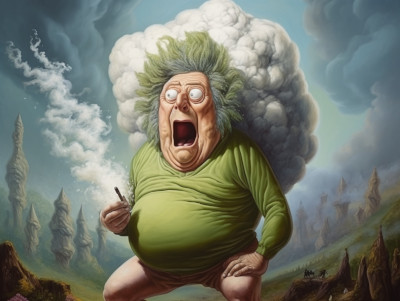The Art of the Fart
A Historical Perspective

Ancient Fartology
The ancient Greeks and Romans were no strangers to flatulence. In fact, they embraced it as a form of entertainment. Aristophanes, the ancient Greek playwright, included fart jokes in his plays, showing that even the ancients appreciated a good toot1. Philosophers and poets alike found humor in the natural functions of the body, and farting was often used as a metaphor for honesty and earthiness. From the public baths to the grand theaters, the sound of a fart was a familiar and amusing part of daily life in ancient Greece and Rome.
Medieval Toots and Renaissance Rumbles
During the medieval period, flatulence was often associated with humor and jesters. Geoffrey Chaucer’s “The Canterbury Tales” includes references to farting, reflecting the earthy humor of the time2. This period embraced the natural and unrefined aspects of life, and farting was seen as a humorous expression of our shared human experience. In the Renaissance, the revival of classical literature brought back the appreciation for bodily humor, and works like Rabelais’ “Gargantua and Pantagruel” celebrated the fart with gusto and wit.
Victorian Gas and the Age of Elegance
The Victorian era gave rise to “Le Pétomane,” a French flatulist performer who entertained audiences by playing musical tunes with his farts. His performances were well-documented, and he became a sensation in Paris during the late 19th century3. Le Pétomane’s artistry elevated the fart to a form of entertainment, showcasing the creativity and humor that can be found in the most unexpected places. His act was not just a novelty but a carefully crafted performance that celebrated the human body’s ability to create sound and rhythm. The Victorian fascination with the exotic and the bizarre found its perfect expression in Le Pétomane’s musical flatulence.
Modern Fart Culture
In modern times, the fart has found its place in movies, television, and even politics. The iconic fart scene in “Blazing Saddles” is a classic example of how flatulence has been used for comedic effect in cinema4. Today, fart jokes continue to resonate with audiences of all ages, reflecting a universal appreciation for this simple yet endlessly amusing bodily function. From animated shows like “South Park” to comedy films like “Dumb and Dumber,” the fart has become a staple of modern humor. Even in the world of politics, an accidental fart caught on a live microphone can become a viral sensation, reminding us that no one is immune to this most human of experiences.
The Future of Farts
What does the future hold for the humble fart? With advances in science and technology, perhaps we’ll see fart-powered cars or even fart-based renewable energy. The possibilities are endless, and the future is windy. As we continue to innovate and explore new frontiers, the fart may yet find new ways to surprise and delight us. Researchers are even studying the composition of farts to understand gut health and diagnose diseases. The fart, once a subject of mere amusement, may become a valuable tool in medical science. Who knew that something so simple could hold such potential?
Embrace the Fart
From ancient philosophers to modern comedians, the fart has been a constant companion in our journey through history. It has brought joy, laughter, and sometimes a cringe or two. So the next time you feel a rumble in your tummy, don’t hold back. Let it rip and become a part of the grand symphony of farts that has echoed through the ages. Embrace the fart, for it is a part of who we are, a reminder of our humanity, and a source of endless amusement. Whether in art, literature, science, or entertainment, the fart continues to inspire and entertain. It’s a universal language that transcends cultures and generations, a simple pleasure that connects us all.
Sources:
1. Henderson, Jeffrey. “Aristophanes: Frogs, Assemblywomen, Wealth.” Harvard University Press, 2002.
2. Chaucer, Geoffrey. “The Canterbury Tales.” Translated by Nevill Coghill, Penguin Classics, 2003.
3. Hartzman, Marc. “American Sideshow.” Penguin, 2006.
4. “Blazing Saddles.” Directed by Mel Brooks, Warner Bros., 1974.
